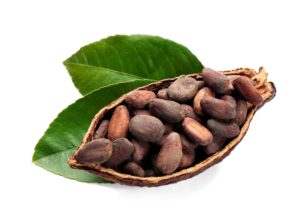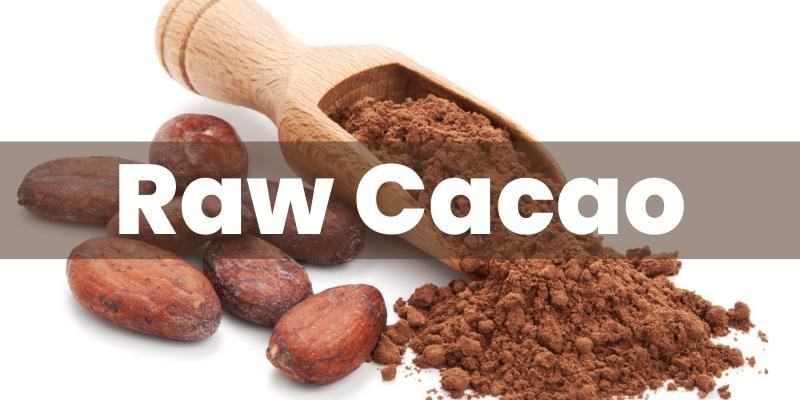What is Raw Cacao?
Raw cacao is the most prized form of cocoa beans. It is unprocessed and has not been heated above 105 degrees Fahrenheit. No chemicals or sugar are added. Raw cacao contains more antioxidants than processed cocoa, which makes it a healthier choice. (see our article on the health benefits of cacao)
Raw cacao is said to have a stronger flavor and more antioxidants than processed cocoa. The beans are typically sun-dried, which gives them a slightly darker color and a nuttier flavor than chocolate chips made from processed cacao. Raw cacao is a great choice for baking because the nuts and bitterness in the beans contribute to rich and chocolatey flavors.
The cocoa powder consists of a pressed mass of cacao beans. This product is ground and often treated with an alkali to remove fat and other impurities. Cocoa powder is used in baking, making chocolate milk, and for making desserts like chocolate chip cookies.
The cocoa tree, Theobroma cacao, originated from Central and South America, where it was cultivated and the seeds of its fruit were consumed by the Pre-classic Mayan civilization as early as 600 BC. A complex chemistry is involved in the transformation of a bitter, astringent, and unpleasant raw material into the characteristic cocoa by-products such as cocoa powders, cocoa liquor, and cocoa butter that enable the characteristic flavor and aromas of chocolate. Fermentation and roasting are of primary importance in this transformation. Cocoa remains an important global commodity due to its fundamental role for the manufacture of chocolate and as an enabler in the production of many foods. Certain cocoa-derived products, such as dark chocolate, have demonstrated cardiovascular health benefits due to their relative abundant concentration of flavanols, specifically (-)-epicatechin.
César Vega, Catherine Kwik-Uribe, 2 – Theobroma cacao—An Introduction to the Plant, Its Composition, Uses, and Health Benefits, Editor(s): Nissim Garti, Neil R. Widlak, Cocoa Butter and Related Compounds, AOCS Press, 2012, Pages 35-62, ISBN 9780983079125, https://doi.org/10.1016/B978-0-9830791-2-5.50005-0.
(https://www.sciencedirect.com/science/article/pii/B9780983079125500050)
Cocoa powder is widely used in the manufacturing of cocoa-based products as drinks, cake fillings, ice cream, and so on. To convert cocoa liquor (generally alkalinized cocoa liquor) to cocoa powder, a defatting process is performed by pressing liquor in a mechanical or hydraulic press at 400–500 bar and a temperature of 90–100 °C. In this way part of the fat (cocoa butter) is removed, and cocoa cake (compressed cocoa powder) is produced. Cocoa powder is obtained by grinding cocoa cake. Generally the fat content of cocoa powder is 10–24%.
Cacao Beans
 Cacao beans are often confused with coffee beans because of their similar size and shape. The beans are roasted and ground to make cacao powder. Cacao is mostly found in its raw form as chocolate, which is a mix of cocoa butter, cocoa solids and sugar. The beans are of a reddish brown color and are slightly wrinkled, and are about the size of a large cherry, but with a thinner shell.
Cacao beans are often confused with coffee beans because of their similar size and shape. The beans are roasted and ground to make cacao powder. Cacao is mostly found in its raw form as chocolate, which is a mix of cocoa butter, cocoa solids and sugar. The beans are of a reddish brown color and are slightly wrinkled, and are about the size of a large cherry, but with a thinner shell.
Cacao Nibs
Raw cacao beans are also known as “nibs” and they must be ground into a powder or pastille before use. Cacao nibs have a bitter flavor, but they are rich in antioxidants. Cacao nibs are often added to baking mixes or used as a topping on ice cream and yogurt. The nibs are the nuts that are left over after the chocolate has been dried. Cacao nibs have a very strong, bitter flavor and they can be used in recipes as an alternative to nuts. In the traditional Aztec diet, cocoa was used as a medicine. The Aztecs believed that drinking chocolate increased blood flow to the brain and could cure headache, fever, and other ailments.
Raw Cacao Butter
Raw cacao butter is the unprocessed cocoa butter that is still in its bean form. It has a bitter, astringent, and slightly fruity taste and is used mostly in baking recipes.
Cocoa butter (CB) is an important ingredient in chocolate and other confectionery industries.
Raw cacao butter has a high level of antioxidants, which can help protect against cancer and heart disease. The fats in the butter help to stimulate insulin secretion and improve blood sugar regulation. Apart from being rich in antioxidants, raw cacao butter is also full of fiber. It helps to reduce bad cholesterol and increase good cholesterol levels by reducing the amount of LDL (bad) cholesterol in the blood.
Raw cacao butter can also help to improve blood pressure and the function of your heart. If you are following a low fat diet, it is highly recommended that you consume raw cacao butter as it will not give you the same effect as regular butter would. Raw cacao butter has a very characteristic, sweet chocolate aroma and taste. You will love to eat it straight from the jar on its own or in raw desserts! It’s delicious with just some almonds and honey. And you can add it into your smoothies for a boost of antioxidants.
Cocoa butter obtained from pressing is separated, filtered, and reused as an ingredient for chocolate and many cocoa-derived products.
Cacao Nibs Nutrition
Raw cacao is the highest quality form of cocoa powder. It has not been treated with any chemicals, heat, or other processes that may alter its flavor or nutritional value. Raw cacao is commonly used in baking because of its intense chocolate flavor and high antioxidant content. Cocoa powder is a mixture of cocoa beans with whatever other ingredients are added to the mix. It is often mixed with sugar, salt, and vanilla. Cocoa powder can be used in place of unsweetened cocoa powder when making chocolate milk or desserts. A good rule of thumb is to use the least amount of sweetener needed for your recipe. If you are using a lot, you will need more than if you are using less.
Caffeine and theobromine are the most abundant methylxanthines in cacao and their physiological effects are notable. Their health-promoting benefits are so remarkable that chocolate is explored as a functional food. The consequences of adenosine receptor blockade by natural compounds present in cacao/chocolate are here reviewed. Palatability and health benefits of methylxanthines, in general, and theobromine, in particular, have further contributed to sustain one of the most innocuous and pleasant habits: chocolate consumption.
Franco R, Oñatibia-Astibia A, Martínez-Pinilla E. Health Benefits of Methylxanthines in Cacao and Chocolate. Nutrients. 2013; 5(10):4159-4173. https://doi.org/10.3390/nu5104159
History of Cacao
Cacao is known to have been used for thousands of years by the indigenous peoples of Central and South America. The Aztecs in Mexico and the Mayans in Central America used it as a ceremonial drink. Cacao beans grow in pods that are harvested from the cacao trees by picking them off the ground. It is grown in a number of countries, including Brazil, Bolivia, Cameroon, Ivory Coast, Ecuador, Indonesia and Madagascar. Cacao was first cultivated in South America.
